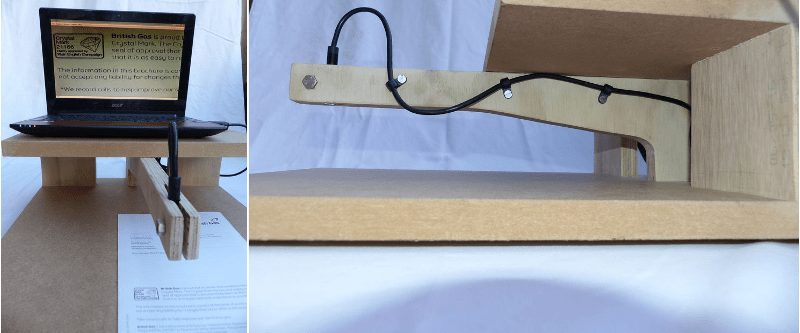Borescope cameras are great inspection tools. They’re flexible, they magnify on a variable scale, and they come with their own lighting. Oh, and they’re pretty cheap, too. Because of all this, these tiny cameras can serve a number of purposes. Doctors put them down your cake hole to look for ulcers and polyps, and mechanics probe pistons with them to check for buildup. [agulesin] used one to make a reading aid for his mom.
Mom suffers from macular degeneration, and can’t read print smaller than 1″ (2.5cm). This condition can cause issues ranging from blurred vision to complete loss of vision in the center of the visual field. Standard handheld magnifiers can work fairly well depending on a person’s condition, but they only provide a fixed magnification level and most offer no lighting.
[Agulesin] had the idea to make a reading magnifier by feeding video from a downward-facing borescope camera to an old netbook. The camera is mounted in a plywood arm that’s fixed to a bi-level platform made from scrap MDF. It’s a simple idea that’s well executed—just project flat, printed material on to a vertical screen. There’s nothing for the user to hold or mount, and no risk of neck strain from looking down over the material.
With any simple project comes limitations. The camera is fixed in place. This rig built to view sheets of A4 paper (between letter and legal size) that are moved around by the user, and it can only handle a stack of so many sheets. If [agulesin]’s mom tried to read a thick novel this way, the camera would likely not focus. Even so, it’s a great piece of assistive tech for people with low vision.

















Remember ages ago something similar although I believe it was CCTV based. Pretty good for the time.
Cake hole?
You could probably use VLC or another software to aggregate multiples of these video feeds together to enlarge and stitch the FOV and see more of the image at once.
Something kind of like the Video Wall feature. https://software.grok.lsu.edu/article.aspx?articleid=14623
Which hole do you put your cake in?
if you are eric cartman then you definitely do it in reverse :)
there’s a similar camera for that…
Should better not mix them up :-)
In my old school (for blind and visually impaired) we had CRT B/W monitors on stands with movable platform under the monitor, In the base of monitor there were two lamps and camera, whole thing had controls for zoom, brightness, contrast and even negative mode. There was also one such device made of old TV and security camera. That one was older than me…
Low vision people usually like inversion of colors, specially black to white and vice versa.
I tried one of the inverting plug-ins for Firefox just for fun, although I don’t have vision problems. I don’t appreciate looking at brightly lit white areas of a page. I freaked out when I took it to HaD. Not needed. HaD is so easy to read on even a small screen. If paper was black and ink white?
What a great project! Macular degeneration really sucks. Commercial video magnifiers (“CCTVs”) exist, but they cost thousands of dollars like any other hopefully-subsidized peripheral for the visually impaired. This should have been a HaD Prize entry.
The commercial devices do have features to enhance contrast, like false color and negative mode as @Moryc noted above. It’d be pretty straightforward to make an economical turnkey equivalent using a Raspberry Pi with camera module, a rotary encoder to select display mode, a large monitor, some kind of stand, and custom software booting straight into CCTV mode.
What a coincidence..
Just last sunday during our visit to my grandmother, who suffers the same illness, we decided that I should build such a reading aid for her. The parts have already been ordered, but I’ll be going the dash-cam plus small bright TV route instead. … if the dash-cam doesn’t clutter up the HDMI image output with all the data from the internal display.
so is it cheaper than a few lenses and mirrors like in a microfilm reader ?
Probably. Also doesn’t require a hugely powerful light-source on the page in order to get sufficient brightness at the high magnification.
Certainly smaller and lighter except for the “TV as big as you want” part.